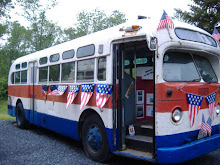
As I promised yesterday, I would continue the story of the Johnstown Traction Co. bus that the Museum owns. Here it is shown during our 2005 Spring Fling at our old Myerstown storage facility: a 1948 GMC TDH3207, Johnstown Traction Company Bus No. 402.
Here's a history of this company: Seeing a need for public transit in the city, local businessmen on April 18, 1882, organized a street railway to provide horse car service. The organizers received a charter on May 8 of that year, under the name of the Johnstown Passenger Railway Co. The Johnstown Traction Co. came into being on Feb. 23, 1910, to operate, by lease, the Johnstown Passenger Railway Co. This lease included all franchises, 31.3 miles of track and 108 cars. Moving along with transportation improvements, the traction company formed a subsidiary, the Traction Bus Co., to operate motor bus lines that would connect with the streetcar routes. This new company received its charter on Nov; 15, 1922. The first bus began its run seven days later from the Dale trolley loop to Windber, via Geistown. In 1929, the company expanded its bus routes with the acquisition of the Southern Cambria and the Beaverdale and South Fork bus lines after the Southern Cambria Railway folded. With more and more bus routes being added, the traction company, in 1936, saw the need for closer control. On Jan. 1, 1937, the bus companies were merged into the parent firm. In 1938, Westmont residents requested improved service. The Inclined Plane, which carried vehicles for many years, was rebuilt to handle heavier loads, and bus service was initiated via the Inclined Plane to Westmont on an hourly basis.
World War II caused a transit boom. During 1941 and 1942, the company was able to purchase 14 used streetcars and 11 new diesel buses. It rebuilt much of the Southmont line, using rail from the old Somerset line, and replaced rail on the Franklin line. The Office of Defense Transportation ordered bus service cut 20 percent and bus and streetcar lines combined to save gasoline and tires. In August 1942, women began training to operate the buses.
During 1959, the last full year of trolley service, the company had 38 cars (16 PCCs, 18 Lightweights, 4 work), 27 trolley coaches and 45 buses. It operated 27.04 miles of streetcar lines and 7.7 miles of trackless trolley route. All rail operations were halted on June 11, 1960, and buses were substituted. Trackless trolley operations were terminated and converted to bus service in November 1967. The Johnstown Traction Company continued operating buses until December 1, 1976, when service was provided under a lease agreement with the newly created Cambria County Transit Authority. The Authority purchased all assets of the company the following year and the Traction Co. was dissolved.
We feel privileged to own the only Johnstown Traction Bus left in existence. There are several trolley cars from the Johnstown Traction Company at local Museums (Rockhill Trolley Museum in Huntingdon County recently refurbished their car and the Pennsylvania Trolley Museum in Washington, PA, also has a car. Also the trolley Museum in Kingston, NY and the two CT trolley Museums have Johnstown Trolleys; Seashore Trolley Museum in Maine has a Trolley Bus). As I talked about yesterday, one of our fareboxes on the floor of the Museum is dedicated to collecting funds to repaint our Johnstown Traction Bus--it was used for the movie "The Good Shepherd" and remains in the colors/paint job from this movie. If you can't make it to the Museum to drop your donation into this farebox, please feel free to mail us your contribution toward repainting this bus in Johnstown Traction colors by sending it to Museum of Bus Transportation, 161 Museum Drive, Hershey, PA 17033 - earmark it for Johnstown Traction Repaint.

No comments:
Post a Comment